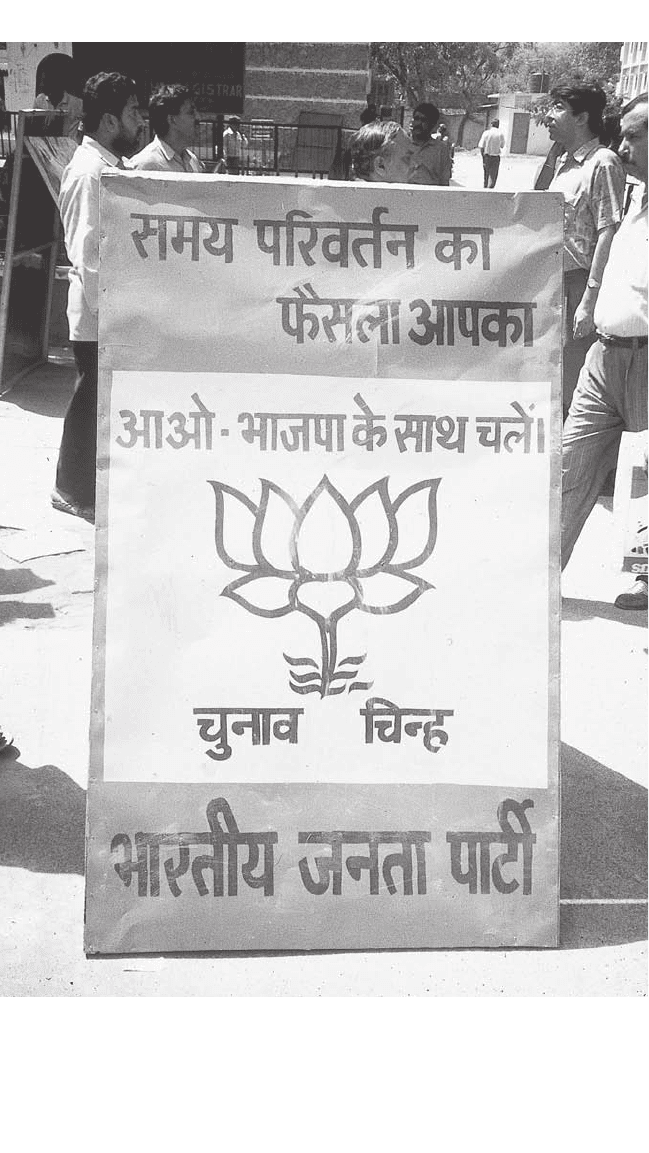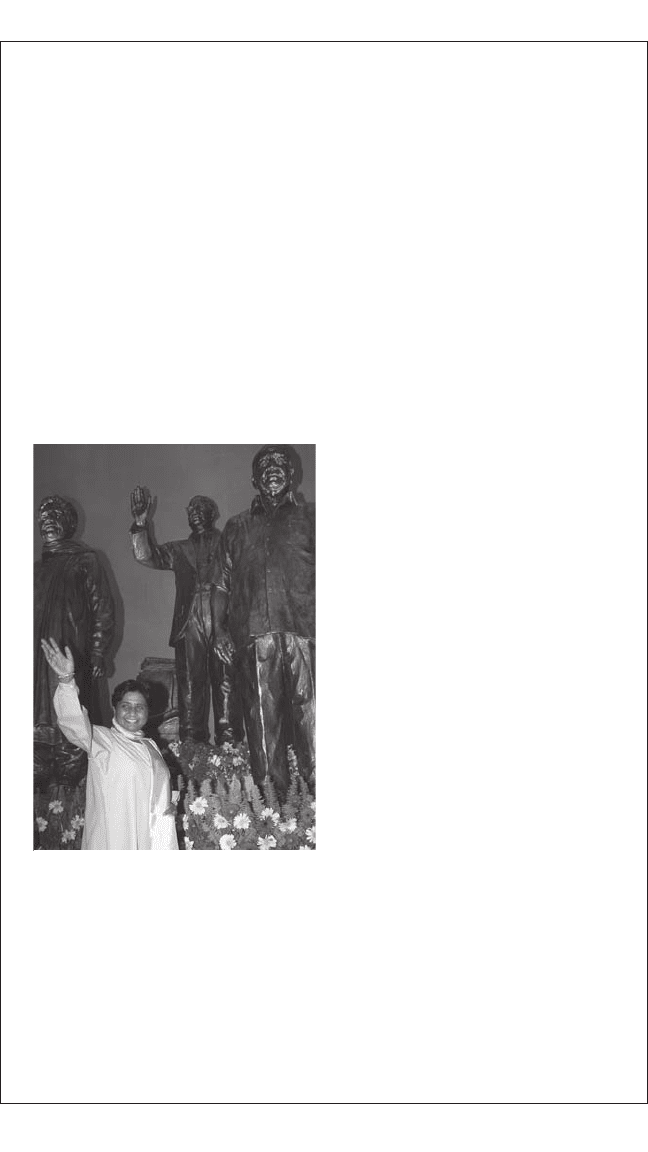Walsh J.E. A Brief History of India
Подождите немного. Документ загружается.


A BRIEF HISTORY OF INDIA
292
the restricted list in what was probably intended as a bid for communal
Hindu support.
“Pop” Diversifi cation
Over the decades since independence, India became not only a more
populous society but a more urbanized one. Indian popular culture
developed along with and as a result of city life and a new consum-
ing middle class. Initially the popularity of fi lms and fi lm songs gave
Bollywood a monopoly over Indian audiences and guaranteed that its
version of popular culture would dominate. Television, as fi rst devel-
oped through the government-controlled Doordarshan, also seemed to
offer another medium for the transmission of a centrally produced pop-
ular culture. But in the 1980s and 1990s, cheap cassette tapes and new
satellite networks broke Bollywood’s and Doordarshan’s control over
popular culture. Indian music now ranges from fi lm songs to religious
tapes, and from regional bawdy songs to virulent communalist propa-
ganda. Television also now offers regional channels in the vernacular
for the discussion and display of local issues and culture. Urban Indian
culture still dominates India, and with 20 percent of villagers now own-
ing TV sets, rural areas have grown increasingly conscious of the many
forms of popular culture produced in the cities.
Village Indians, as it turned out in the elections of 2004, have also
become more aware of other aspects of urban life. Not only have rural
residents participated in the religious and political movements of the
past 15 years, they have also made clear that they are aware, as perhaps
never before, of the vast economic gulf that still separates urban and
village ways of life.
001-334_BH India.indd 292 11/16/10 12:42 PM

293
10
India in the
Twenty-first Century
(1996–2010)
Anger. The major feeling is anger. You can call one chapter “anger.”
The middle classes are 2 percent of the population and they are not being
represented. There is no representation. The interests of the
middle classes are not being represented by politicians.
Mumbai journalist in interview (Fernandez 2006, 186)
My own assessment is that Indian democracy is working quite well,
and is moving towards being more participative and giving power to
the lower caste. And it is through this movement that the lower caste
is asserting themselves. So I think it is within our reach through democracy
only to upset that hegemony of the upper caste.
Jawaharlal Nehru University Dalit student (Jaffrelot 2008, 48)
T
he rise of a Hindu majoritarian party in the 1980s and 1990s again
highlighted the difficulties of democratic majority rule in a country
with distinct minority populations and multiple religious communities.
this had been an issue in debates over seat reservations and separate
electorates before 1947. in the 1990s it reemerged as the VHP and BJP
provoked riots over the Babri Masjid and as the BJP came to power in
1998 and 1999 at the head of coalition governments.
By 1999 observers had agreed that the BJP’s main supporters were
urban, upper-caste Hindus and those from the growing middle and/or
upper classes. But, while Hindu nationalism was, in theory, an ideology
that could appeal to the 80 percent of indians who were Hindus, an elec-
tion reversal in 2004 demonstrated that majoritarian politics might just as

A BRIEF HISTORY OF INDIA
294
BJP poster, New Delhi, 1996. An unoffi cial poster for the BJP urges (in Hindi) “Time for a
Change—Your Decision” and “Come! Let’s go with Bhajpa” (a colloquial name for the BJP).
The lotus, the election symbol for the BJP, is the central image of the poster.
(courtesy of
Philip Oldenburg)
001-334_BH India.indd 294 11/16/10 12:42 PM

295
INDIA IN THE TWENTY-FIRST CENTURY
easily be defi ned along caste (or class) lines—and that in such divisions,
the majority among voters could lie with rural voters, with the poor, and
with the communities of OBCs and Untouchables. A second, and almost
equally unexpected, national election in 2009 saw further victories for the
Congress and a further erosion of BJP support. Analysts were left wonder-
ing if the Congress Party had managed to reassert its earlier dominance
over Indian politics or if, alternatively, the golden bird of India’s prosper-
ous, globalized economy trumped the saffron identity of Hindutva.
Fragmented National Power
In the aftermath of the Babri Masjid demolition and violence, the BJP
dropped its emphasis on Ayodhya and attempted to widen its constitu-
ency by focusing on an economic and social agenda. In 1996 the party
won 161 seats in Parliament and tried for 13 days to form a government
with Vajpayee as prime minister but failed to fi nd coalition partners
because of its aggressive Hindutva stand. Janata Dal politician H. D. Deve
Gowda (1933– ) became prime minister instead, heading a new coali-
tion government, the United Front, made up of 13 leftist, regional, and
low-caste parties and supported from outside the coalition by Congress
(I) seats.
Gowda was the fi rst regionally based prime minister in India’s his-
tory. He came from a peasant proprietor background and had been chief
minister of Karnataka. He spoke Kannada, the regional language of
Karnataka, and was reputed to know little English or Hindi. Within 10
months of Gowda’s becoming prime minister, Congress (I) had forced
his resignation, replacing him with Inder Kumar Gujral (1919– ),
a relatively obscure Janata Dal member who had served in Congress
governments during the 1960s and ’70s before joining the Janata Dal
in the 1980s. Gujral headed the fourth coalition government to be
formed within the year. In November, however, when a government
commission identifi ed the DMK party from Tamil Nadu (one of Gujral’s
coalition partners) as secret funders of the Tamil group responsible for
Rajiv Gandhi’s assassination, Congress withdrew its support from the
coalition, and Gujral’s government fell.
The BJP Takes Power
National elections in 1998 gave the BJP the largest block of votes in
Parliament—182 seats and 25.5 percent of the popular vote—and the
BJP successfully formed a coalition government with 20 other parties,
001-334_BH India.indd 295 11/16/10 12:42 PM

A Brief History of indiA
296
including the tamil non-Brahman dMK and the tiny Bahujan samaj
Party (BsP). the BJP gained these coalition partners, however, only by
abandoning substantial sections of its Hindutva agenda. the party’s 1998
national Agenda for Governance dropped several long-standing goals:
the building of the ram temple in Ayodhya, a uniform civil code (a covert
attack on the separate Muslim personal law), and ending the special con-
stitutional status of the Muslim majority state of Jammu and Kashmir.
the BJP coalition remained in power with Vajpayee as prime min-
ister for 13 months, until April 1999. Violent attacks against indian
Christians during 1998–99 raised fears that such violence would be
tolerated by a Hindu nationalist government, but the BJP’s fall in 1999
was caused by internal coalition politics. squabbling led to the defec-
tion of both the dMK and the BsP. in the general elections of 1999,
the BJP emerged with the same number of Lok sabha seats (182) but
with a much stronger coalition (294 seats out of the Lok sabha’s 543).
Congress (i), now under the presidency of sonia Gandhi (the italian-
born wife of rajiv Gandhi), won only 114 seats. Vajpayee’s return as
prime minister marked the first time in 27 years an incumbent prime
minister had been voted back into office.
Analysts from Frontline, a national english-language newsmagazine,
declared at the time that the BJP (and its allies) had created “a new
social block” in election politics (yadav et al. 1999). this was not the
creation of a “simple Hindu majoritarianism,” for the BJP had gained its
new allies only by abandoning much of its explicitly Hindutva agenda.
rather, it was the creation of a voting bloc in which caste hierarchy and
class hierarchy reinforced each other in supporting the BJP coalition.
Poll data collected by the Center for the study of developing societies
(Csds) indicated that the BJP and its allies had secured 60 percent
of the votes of upper-caste Hindus and 52 percent of the votes of
Economic Class in the Elections of 1999
(as a percentage of each party’s total votes)
All Votes
Congress BJP Regional in 1999
(I) BJP allies Left BSP Parties Election
Upper strata 34 69 49 28 13 39 45
Lower strata 66 31 51 72 87 61 55
source: Csds poll data as summarized in yadav et al. 1999.

297
INDIA IN THE TWENTY-FIRST CENTURY
dominant (non-OBC) Hindu peasant castes. Looked at in class terms—
through a simple division of the electorate into an “upper strata” and a
“lower strata”—the BJP drew 69 percent of its votes from the 45 percent
of Indian voters in the upper strata. Thus, the BJP might be said (with
only some exaggeration) to represent “the rebellion of the elite” or, at
least “the emergence of a new social group that is defi ned by an overlap
of social and economic privileges” (Yadav et al. 1999).
Upward Caste Mobility
Frontline’s 1999 analysis of the elections concluded with the ques-
tion: “. . . if the privileged can form a bloc, why not the underprivi-
leged?” In the 1980s and 1990s a new type of upward caste mobility
had appeared in the North Indian Hindi belt region. This mobility
had appeared fi rst in South India during the late 19th and early 20th
centuries: Non-Brahman castes changed their social status through
ethnicization, that is, by moving outside narrow, endogamous jati def-
initions to establish broader ethnic identities. The caste associations
of the 1880s–1930s were often the vehicles for such new identities in
south India. Some associations even replaced Sanskrit varna classifi ca-
tions with the regional and ethnic identity of Dravidians. In the 1920s
and ’30s, the Tamil leader Periyar had used the idea of Dravidian iden-
tity to organize his Self-Respect Movement. Even before 1947 a strong
non-Brahman movement in Tamil Nadu had forced its members into
the region’s English-language schools and had gained control of the
regional Congress movement.
In contrast, in northern India Sanskritization had long been the pre-
ferred method for upward caste mobility. Even as late as 1947, the English-
educated elite of North India came mostly from the upper castes, and these
upper-caste members provided the leadership for most of the North’s social
and political movements. In the 1980s and ’90s, however, North Indian
social and political groups began to organize low castes and Untouchables
outside the rituals, customs, and practices of Brahmanic Hinduism and
into politicized ethnic identities analogous to those of the south.
Rising Power of Lower Castes
That upper-caste mobilizations against the Mandal Commission
reforms had produced counter-organization among low-caste and
Dalit (Untouchable) communities became clear in Lok Sabha and
state elections in the 1990s. The two parties that benefi ted most
001-334_BH India.indd 297 11/16/10 12:42 PM

A BRIEF HISTORY OF INDIA
298
from this politicization were the Samajwadi (Socialist) Party, an
organization founded in 1992 that focused on OBCs in Bihar and
Uttar Pradesh, and the Bahujan Samaj Party (Party of the Majority,
or BSP), an Untouchable party that had worked on organizing coali-
tions of low castes and Dalits since its founding in 1984. Two OBC
leaders from the regional, low-caste Yadav community—Mulayam
Singh Yadav (1939– ) in Uttar Pradesh and Laloo Prasad Yadav in
Bihar—used the Mandal reservations and the more politicized lower-
caste climate for the benefi t of their own OBC Yadav community in
these states.
The BSP was founded by Kanshi Ram (1932–2006), a Punjabi from
a low-caste family. During the late 1960s Kanshi Ram had cut himself
THE BANDIT QUEEN
T
he dramatic life of Phoolan Devi (1963–2001) made Indian news-
paper headlines in the 1980s and 1990s, offering Indian readers
an illustration of rural low-caste women’s lives and of the growing vis-
ibility of the Other Backward Classes (OBCs). Phoolan Devi was the
second daughter of a lower-caste peasant in a small Uttar Pradesh vil-
lage. By age 20 she had became the mistress of Vikram Mallah, leader
of a local dacoit (bandit) gang. When Mallah was killed by a treacherous
friend, Phoolan Devi was kidnapped, raped, and humiliated by high-
caste thakur men from the village of Behmai. In revenge, on Valentine’s
Day 1981, she and her dacoits massacred 22 thakur men from Behmai,
later said to be the same men who had raped her. She escaped capture
for two years, becoming famous as one of India’s most hunted dacoits,
before surrendering under a plea agreement in 1983.
During her 11-year imprisonment Phoolan Devi was befriended
by a journalist who published her story as India’s Bandit Queen, a
best-selling book and then a Bollywood fi lm of the same name. After
release from prison in 1994, Phoolan Devi married and converted to
Buddhism; in 1996 she ran for Parliament as a Samajwadi Party can-
didate in Uttar Pradesh, defeating an upper-caste candidate for the
Lok Sabha seat, part of the rise to power of OBCs in that state. In
2001 Phoolan Devi was killed outside her New Delhi home by three
masked gunmen. The man accused of her murder, Sher Singh Rana,
claimed he had killed her to avenge the death of high-caste Uttar
Pradesh men, but other reports suggested Phoolan Devi’s husband
had been involved in her murder.
001-334_BH India.indd 298 11/16/10 12:42 PM

299
INDIA IN THE TWENTY-FIRST CENTURY
MAYAWATI
The elephant (BSP logo) is really the wise Ganesh, the trinity of
gods (Brahma, Vishnu, Shiva) rolled into one. (BSP campaign
slogan, 2007)
I
n 1995 a BSP coalition took control of the state government of
Uttar Pradesh, and Mayawati (1956– ), an Untouchable convert
to Buddhism, became the state’s chief minister. Mayawati was born
into a Jatav (Untouchable) community in the Uttar Pradesh district of
Bulandsahar and grew up in New Delhi where her father was a clerk
in a government offi ce. She graduated from college in New Delhi and
has bachelor degrees in both law and education. She initially worked as
a teacher in New Delhi until 1977 when she met Kanshi Ram and gave
up plans to study for the Indian
Administrative Service to join him
in political work. “You won’t even
become a local municipal corpo-
rator,” her father is said to have
warned, “if you hang around los-
ers like Kanshi Ram” (Bose 2008).
In 2001, Kanshi Ram named
Mayawati as his successor in the
BSP organization.
Her fi rst appointment as chief
minister in Uttar Pradesh lasted
less than fi ve months, but she was
returned to power in 1997 and
again in 2002–03; all three times
she was at the head of coalition
governments. In the summer of
2007, however, the BSP won an
absolute majority in the state,
and Mayawati and the BSP came
to power.
Throughout her terms in offi ce
Mayawati has attracted both con-
troversy and criticism. It is said
that she has accumulated a large
personal fortune and has a vast
collection of diamonds and silk
Mayawati, 2007. Bahujan Samaj Party
(BSP) leader Mayawati standing before
statues of herself, the Dalit leader
Ambedkar (center), and the founder of
the BSP party, Kanshi Ram in Lucknow,
Uttar Pradesh. Mayawati was celebrat-
ing the 2007 election victory that
would make her chief minister of Uttar
Pradesh, India’s largest state.
(Ajay
Kumar Singh/Associated Press)
(continues)
001-334_BH India.indd 299 11/16/10 12:42 PM

A BRIEF HISTORY OF INDIA
300
saris. Her 2007 fi ling with the government stated her cash and assets
at 520 million rupees ($10.4 million). Claims of corruption (common in
most Indian political parties) have resulted in lawsuits against her.
Some political analysts, however, believe that the BSP and Mayawati
have built their strong following in Uttar Pradesh through a com-
bination of policies that consolidate Dalit support and policies that
benefi t other impoverished communities. In her fi rst term in offi ce in
1995, Mayawati demonstrated the possible benefi ts of political power
for low-caste and Untouchable communities in the state. She put
BSP supporters into key administrative posts throughout the state,
appointing Untouchable district magistrates in almost half of Uttar
Pradesh’s districts. A village redevelopment scheme was expanded
to include Untouchable villages and to locate its roads, pumps, and
houses within Untouchable neighborhoods. Grants were increased
to allow Untouchable and Muslim children to attend primary school;
20 percent of police inspector posts were reserved for Untouchables.
Muslims were also made eligible for reserved seats in the state admin-
istration. As of 2009, one in every fi ve voters in Uttar Pradesh was
a Dalit and almost 80 percent support the BSP. In the 2007 election,
Mayawati further consolidated her party’s hold by reaching out to
other castes in the state, giving even Brahman candidates seats on her
party’s ticket.
An Indian Express reporter wrote in 2003 of the changes seen by
Dalits in Uttar Pradesh:
Check with the Dalits of these villages. They will tell you this was
God’s forsaken country. They tilled the land of the upper castes,
looked after their animals, washed their clothes, shaped their pots,
made their shoes and cleaned their mess. In turn, they were declared
untouchable and unclean—and forced to live in the dirtiest quarters
of the village. . . . “There was a time when we were scared to speak
out, even look up [one villager told the reporter]. Now we go and
meet the tehsildar, the thanedar [government offi cials] and they
listen to our complaints.”. . . Everyone concedes that there can be
no comparison between the old days and the present. (Sheth 2004)
Source: Bose, Ajoy. “Excerpt from Behenji.” Tehelka Magazine 5, no. 18
(2008). Available online. URL: http://www.tehelka.com/story_main39.
asp?fi lename=Ne100508a_miracle.asp. Accessed January 27, 2010; Sheth,
D. L. Caste, Ethnicity and Exclusion in South Asia: The Role of Affi rmative Action
Policies in Building Inclusive Societies (United Nations Development Programme,
Human Development Report Offi ce, 2004), pp. 50–51.
MAYAWATI (continued)
001-334_BH India.indd 300 11/16/10 12:42 PM

301
INDIA IN THE TWENTY-FIRST CENTURY
off from his family, vowed never to marry, and dedicated himself full
time to the organization of low-caste people. Inspired by the writings of
Ambedkar and Phule, Kanshi Ram believed that the future of low castes
lay in political unity. Between 1989 and 1991 the BSP averaged almost
2 percent of the vote in national elections and had won several seats in
the Lok Sabha. In the 1996 national elections, the party won 11 seats,
and in 1998 it won fi ve seats.
OBCs and Dalits in Government
By 1999 more-politicized OBC communities had made signifi cant
gains in both the Lok Sabha and state assemblies in Hindi-belt states.
In general the Lok Sabha became much less upper caste in the decades
between 1952 and 2002. Where in 1952, 66 percent of all Lok Sabha
members were from the upper castes, in 2002 only 33 percent were.
The OBCs’ overall parliamentary presence also increased. Where in
1977 OBCs made up 10 percent of the Lok Sabha’s members, in 2002
they made up 25 percent.
In the Hindi-belt states of Uttar Pradesh, Madhya Pradesh, and Bihar,
the years from 1989 to 1999 saw a dramatic change in the representation
of OBCs in state assemblies. In 1989 the percentage of OBCs in Parliament
had been only 10.6 percent in Uttar Pradesh, 7.5 percent in Madhya
Pradesh, and 18.5 percent in Bihar. Ten years later, however, OBCs were 25
percent of the members of Parliament from Uttar Pradesh, 23 percent from
Madhya Pradesh, and 29 percent from Bihar. At the same time, the percent-
age of upper-caste members of Parliament from the three states had also
fallen, from an average of 48 percent in 1989 to only 33 percent by 1999.
At the same time, the Bahujan Samaj Party (BSP) was contesting elec-
tions on a national basis by 1998 and by 1999 was averaging 4 percent
of the national vote and had been certifi ed as a national party. The BSP’s
greatest strength was in Uttar Pradesh, Madhya Pradesh, and the Punjab.
In 1995, 1997, and from 2002 to 2003, the BSP ran the state government
in Uttar Pradesh in coalition with other parties. But in 2007, the party
won the state government outright and has remained in power ever since.
The BJP in Power
The BJP’s new National Democratic Alliance (NDA), a coalition of
23 political parties, was strong enough to remain in power for fi ve
years. Chief among its goals was a pledge to continue the globaliza-
tion reforms begun by the Congress Party in 1991. These reforms had
001-334_BH India.indd 301 11/16/10 12:42 PM
